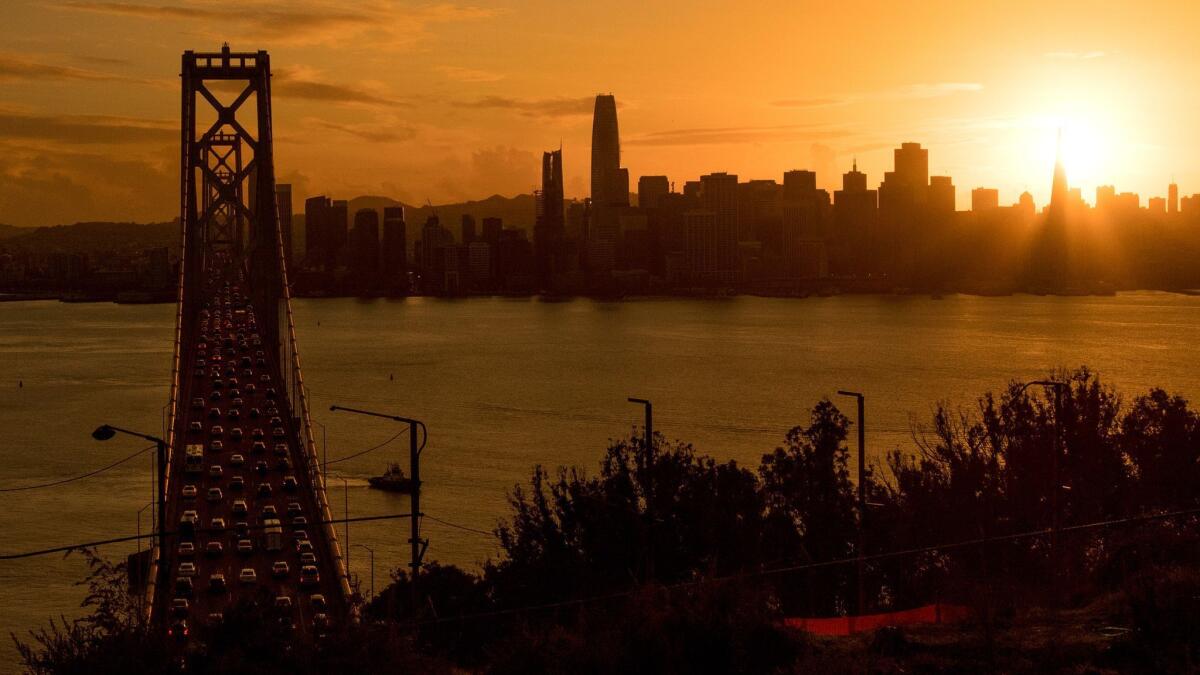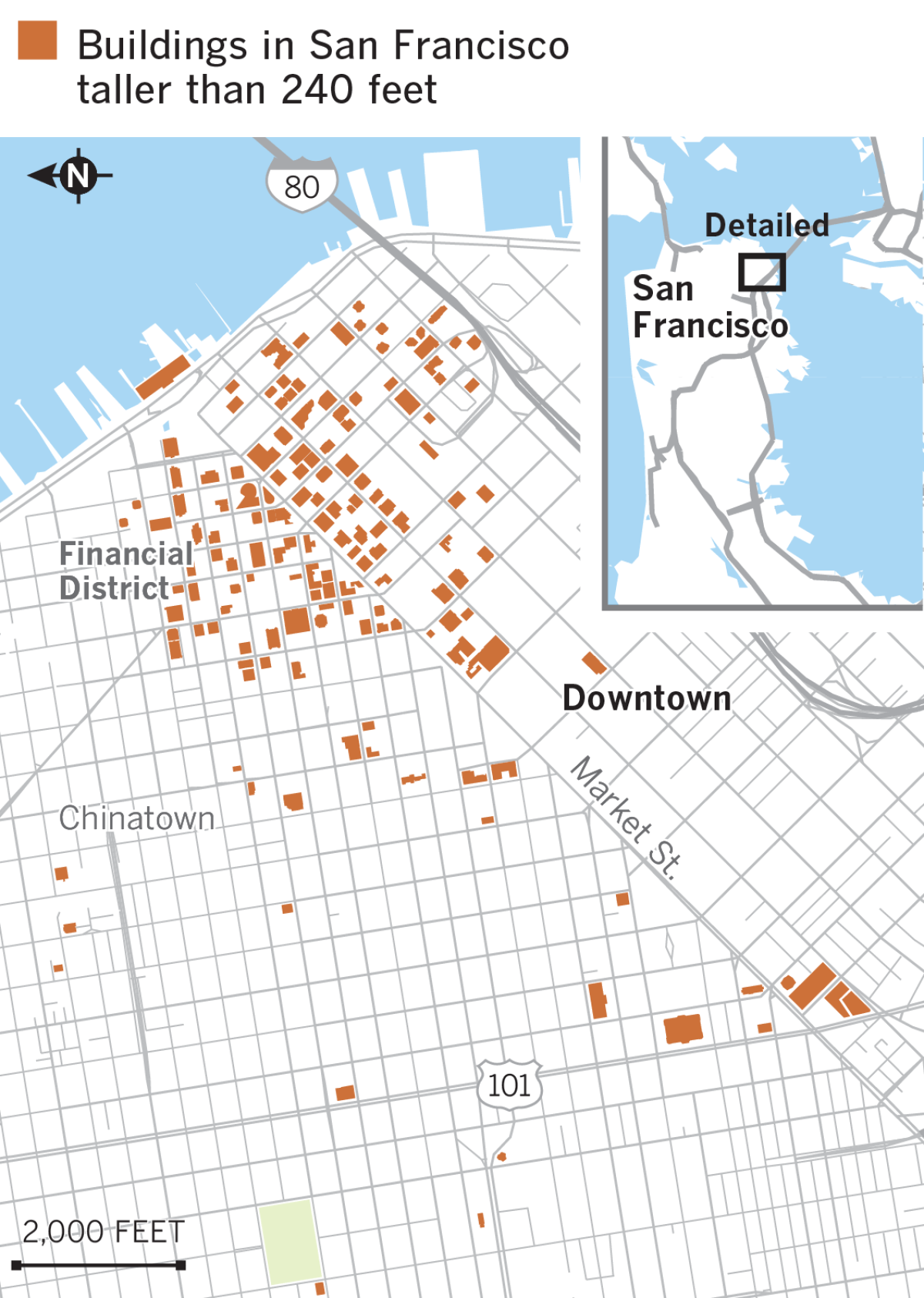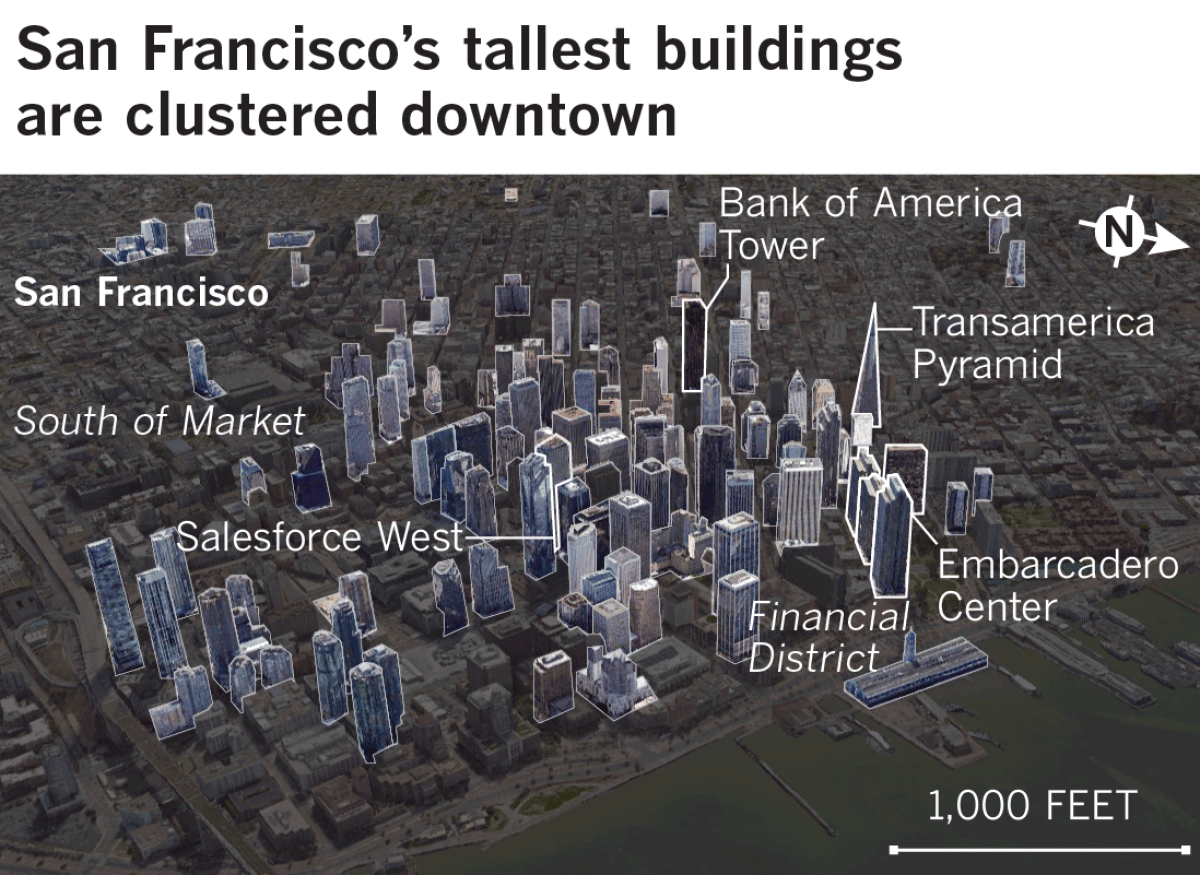Booming San Francisco takes unprecedented step to target earthquake-vulnerable high-rise towers

- Share via
Reporting from San Francisco — For all the tech wealth that has flown into this city in recent years, it’s also an unnerving time for city builders.
First, a centerpiece of San Francisco’s new downtown, the 58-story Millennium Tower, started sinking and tilting. Then last week, the city’s new $2.26-billion transbay bus station was abruptly shut after cracks were found in two steel beams. Both events have fueled anxiety about how San Francisco’s growing skyline would hold up in the kind of major quake that destroyed much of the city in 1906.

So on Thursday, the city opened up a new front on California’s seismic safety, releasing an unprecedented list of more than 150 of its tallest buildings, including many constructed before modern seismic codes.
The inventory is the first step in an assessment of the city’s skyline with an eye toward making costly fixes to towers that could collapse amid major shaking. Officials are also calling for rules for new construction, aimed at preventing unanticipated sinking of buildings as well as making tall buildings even stronger to resist wobbling in an earthquake.
While San Francisco, Los Angeles and other communities have stepped up retrofitting efforts in recent years, no other city in California has gone as far in creating an inventory of identifying landmark skyscrapers downtown that probably need seismic reviews.
Out of San Francisco’s 156 tallest buildings — those taller than 240 feet — roughly 100 were built before the era of modern seismic codes for their building type, according to the study by the nonprofit Applied Technology Council.

That doesn’t mean all of them are at risk of collapse. Further study would be needed to determine if they are vulnerable and need a retrofit.
The list is a starting point. And the experts who compiled the list for City Hall say officials should take action to get more of these buildings structurally evaluated, and have the ones most prone to collapse retrofitted.
“We must act before the next earthquake strikes to ensure the safety of residents, workers and visitors,” said San Francisco City Administrator Naomi Kelly.
The tech boom has brought major development to a relatively small section downtown, which is now being crowded with new skyscrapers, including San Francisco’s tallest, the Salesforce Tower. Missed in all the focus on new construction is how older buildings in the densely packed downtown area — built before modern seismic codes — will fare.
Even the collapse of just one or two could paralyze the city for many blocks for years.
The city has not been tested by a truly cataclysmic earthquake for 112 years. And there remain many buildings built before today’s modern seismic codes. Downtown largely survived the 1989 Loma Prieta quake.
But left untested were many of San Francisco’s brittle concrete and steel-frame buildings. Los Angeles discovered just how vulnerable they could be in its earthquakes in 1971 and 1994.
In the 1971 Sylmar earthquake, 52 people died in the collapse of concrete buildings at hospitals in the San Fernando Valley. And after the Northridge temblor, engineers were stunned to find the skeleton of so-called steel moment frame buildings fractured, leaving about 25 significantly damaged. One — the Automobile Club of Southern California building in Santa Clarita, open for just 21 months — came very close to collapse.
Engineers later discovered that some concrete buildings built through the 1970s failed to have enough reinforcing steel in the frame, allowing concrete to explode out of its columns when shaken. Many steel buildings built from the 1970s through the 1990s were found to have been designed in a flawed way, and there were problems in the way the structures were welded and inspected.
“There is no doubt that those older steel frame buildings are far more likely to collapse than their designers anticipated,” said Keith Porter, a professor of structural engineering at the University of Colorado, Boulder. “A collapse of one of these buildings could not only potentially kill many of its own occupants, but also people in nearby buildings.
“This is a problem we have known about for decades,” Porter said.
Elected officials in California have long been reluctant to confront the issue of ordering retrofits of buildings, fearful of angering property owners about the costs of a retrofit.
But after a Times analysis in 2013 detailed how hundreds may be at risk from collapse of concrete buildings in a major quake, Los Angeles officials approved mandatory retrofits of an estimated 1,500 brittle concrete structures. The Times reported that, depending on where an earthquake strikes, as many as 50 of these buildings in the city alone could be destroyed in a single temblor, exposing thousands to injury or death.
Los Angeles has yet to take action on steel buildings, while the smaller neighboring cities of Santa Monica and West Hollywood recently passed laws requiring vulnerable steel buildings in their cities be retrofitted. Earlier this year, L.A. Mayor Eric Garcetti said the city should consider mandatory retrofits to steel-frame buildings.
The collapse of five high-rise steel buildings in Southern California was seen as possible during a hypothetical magnitude 7.8 earthquake on the San Andreas fault, according to the U.S. Geological Survey’s simulation of such a disaster. If the earthquake hit during working hours, about 5,000 people could be inside those five buildings.
In 1995, when a magnitude 6.9 earthquake hit Kobe, Japan, one-third of 630 modern steel buildings in a heavily shaken area were severely damaged, according to a USGS report. One photograph showed how one story of a steel building collapsed.
San Francisco’s effort at publicizing a list of its buildings marks a new front in seismic safety — making it easier for residents and workers to easily understand the age of the city’s tallest buildings, its structural system, and if there’s a record of retrofit.
The recommendations aiming to get more buildings evaluated in depth, and perhaps requiring retrofits, will probably be controversial.
It can be costly even to just evaluate a tall building, and millions of dollars to retrofit it. While San Francisco is requiring owners of many wood-frame apartments to be retrofit, those costs are small compared with fixing an office tower or high-rise residential building. Kelly, the city administrator, signaled that she backed more than a dozen suggestions she received from the experts to improve the safety of tall buildings.
The rhetoric coming out of San Francisco City Hall represents a shift from just a few months ago, when officials emphasized the difficulty in identifying the city’s largest vulnerable buildings.
Other cities are now renewing talk of seismic safety. After years of delay, Oakland has resumed talking about a mandatory retrofit law for nearly 2,000 possibly vulnerable wood-frame apartment buildings at risk of collapse in a seismic event.
The moves follow a landmark U.S. Geological Survey report released in April about the threat of the Hayward fault to the Bay Area. The report said 800 people could be killed and 18,000 injured in a hypothetical magnitude 7 earthquake centered below Oakland. Oct. 21 will mark the 150th anniversary of the last big earthquake on the Hayward fault.
As part of preparations for that anniversary, some seismic experts urged the public to ask about the earthquake safety of their homes, workplaces, schools and churches.
“Those questions should be more in-depth than just, ‘Will this building survive? And will it be damaged to the extent it’s going to injure me?’” said Keith Knudsen, deputy director of the USGS Earthquake Science Center in Menlo Park, Calif. “They should follow up with questions [like] ‘Will this building be usable following an earthquake?’”
The city ordered the study of tall buildings amid concerns about the safety of Millennium Tower, the skyscraper that has become famous for its sinking and leaning problem. Engineering experts hired by the city say that Millennium’s earthquake-resisting system has not been compromised by the leaning of the building.
Presentations accompanying San Francisco’s inventory said that approximately 10 tall buildings could possibly be brittle concrete, and more than 80 others are believed to be steel-framed buildings constructed before the 1994 Northridge earthquake.

In general, concrete buildings built before 1980, and steel buildings constructed prior to 1997, are thought to deserve scrutiny to assess for seismic deficiencies and determine if an earthquake retrofit is needed.
Just six buildings on the list were found to have undergone modern seismic retrofits, including San Francisco City Hall and the Ferry Building.
The San Francisco study authors said it’s possible the database is incomplete, and asked those with knowledge of retrofits not mentioned in the database to come forward with their information.
Existing San Francisco laws have generally proved ineffective in forcing the owners of tall buildings to seismically evaluate or retrofit them. Current law does require a seismic retrofit when two-thirds of a building’s floors are renovated, but that almost never happens to tall buildings, when only a small fraction of the building undergoes construction at any given time.
The report suggests triggering mandatory seismic evaluations more often during major renovations, but to do so in a way that won’t discourage developers from modernizing buildings. One possible solution is to not require retrofits except for buildings most likely to collapse.
Other possibilities include triggering seismic evaluations when buildings are purchased or leases are renewed, according to the report. Such changes in city law would require support from the Board of Supervisors and Mayor London Breed.
There are other recommendations in the report. One is to order inspections and, if needed, repairs of steel buildings shaken in the 1989 Loma Prieta earthquake. Among others:
- Create rules for new buildings to guard against unexpected sinking.
- Aim to make new buildings stronger so they can resume operations sooner after an earthquake instead of being shut down for two to six months.
- Recommend minimum levels of insurance to ensure buildings and surrounding neighborhoods can recover.
- Study whether automatic fire suppression and evacuation systems in tall buildings can function after shaking.
- Expand the database to include any building taller than 75 feet.
- Create protocols to determine how large a cordon must be around a building at risk of collapse after an earthquake.
Greg Deierlein, a professor of structural and earthquake engineering at Stanford and coauthor of the report, said he was glad to see city officials were enthusiastic about his recommendations. But now comes the hard part.
“The city needs to take these recommendations — and see if it’s politically viable,” Deierlein said.
More to Read
Sign up for Essential California
The most important California stories and recommendations in your inbox every morning.
You may occasionally receive promotional content from the Los Angeles Times.











